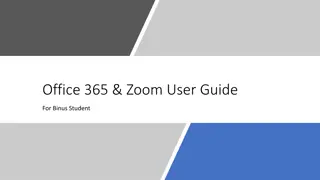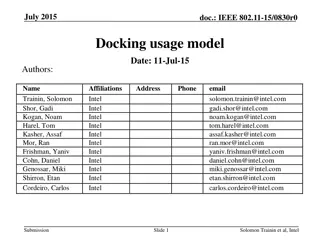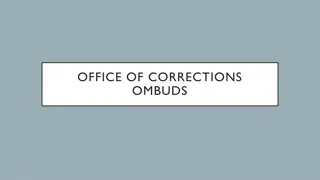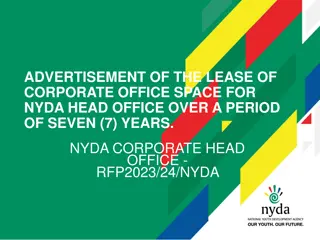15 Steps to Creating the Perfect Home Office
Transform your space with our 15-step guide to the perfect home office. Maximize productivity and comfort for a workspace tailored to your professional needs.nn
Download Presentation

Please find below an Image/Link to download the presentation.
The content on the website is provided AS IS for your information and personal use only. It may not be sold, licensed, or shared on other websites without obtaining consent from the author. Download presentation by click this link. If you encounter any issues during the download, it is possible that the publisher has removed the file from their server.
E N D
Presentation Transcript
15 Steps to Creating the Perfect Home Office 1. What are some home office ideas? When designing your home office, it's important to consider your specific needs and preferences. Here are some home office ideas to inspire you: Choose a dedicated space: Find a separate area in your home that can be designated as your office space. This will help create a clear boundary between work and personal life. Prioritize natural light: Position your desk near a window to maximize natural light. This can boost productivity and improve your mood. Invest in ergonomic furniture: Opt for a comfortable chair and an adjustable desk that allows you to work in a proper posture. This will help prevent back pain and other ergonomic issues. Add storage solutions: Incorporate shelves, cabinets, or drawers to keep your office organized and clutter-free. This will help you stay focused and productive.
Personalize your space: Decorate your office with items that inspire and motivate you. This could include artwork, plants, or meaningful objects. Consider soundproofing: If you live in a noisy environment, consider adding soundproofing elements to your office. This can help create a quiet and peaceful workspace. Create a comfortable seating area: If you have the space, consider adding a cozy seating area where you can take breaks or have informal meetings. 2. What are the best home office setup ideas? When setting up your home office, it's essential to create a functional and efficient workspace. Here are some of the best home office setup ideas:
Choose the right desk: Select a desk that suits your work style and space. Consider factors such as size, storage options, and whether you prefer a standing or sitting desk. Invest in a comfortable chair: Since you'll be spending long hours sitting, invest in an ergonomic chair that provides proper support for your back and promotes good posture. Set up dual monitors: If your work involves multitasking or requires multiple screens, consider setting up dual monitors. This can increase productivity and make your work more efficient. Create a designated work zone: Set clear boundaries by creating a designated work zone within your home. This will help you mentally separate work from personal life. Use cable management solutions: Keep your workspace organized and free from tangled cables by using cable management solutions. This will make it easier to connect and disconnect devices. Incorporate a whiteboard or corkboard: Install a whiteboard or corkboard to keep track of important tasks, deadlines, and reminders. This will help you stay organized and focused. Consider a standing desk converter: If you want the option to alternate between sitting and standing, consider using a standing desk converter. This allows you to adjust the height of your desk as needed.
3. How can I create a productive home office environment? Creating a productive home office environment is crucial for maintaining focus and achieving your work goals. Here are some tips to help you create a productive workspace: Minimize distractions: Identify potential distractions in your home and take steps to minimize them. This could involve closing the door, using noise-canceling headphones, or setting boundaries with family members. Establish a routine: Set a consistent work schedule and stick to it. Having a routine helps create structure and discipline, making it easier to stay focused and productive. Set goals and prioritize tasks: Start each day by setting clear goals and prioritizing your tasks. This will help you stay organized and ensure you're working on the most important and urgent tasks first. Take regular breaks: Break up your workday with short breaks to rest and recharge. This can help prevent burnout and improve overall productivity. Create a clean and organized workspace: A cluttered workspace can be distracting and hinder productivity. Keep your desk clean and organized, only keeping essential items within reach.
Use productivity tools: Explore productivity tools and apps that can help you stay organized, manage your time, and track your progress. Some popular options incldude Trello, Asana, and Evernote. 4. What are some essential items for a home office? Tocreate a functional and efficient home office, there are several essential items you should consider incorporating: Desk: Choose a desk that suits your work style and space. Look for one that provides ample workspace and has storage options if needed.
Chair: Invest in an ergonomic chair that provides proper support for your back and promotes good posture. Comfort is key when spending long hours at your desk. Computer/laptop: Depending on your work requirements, choose a computer or laptop that meets your needs. Consider factors such as processing power, storage capacity, and screen size. Internet connection: A reliable and fast internet connection is essential for remote work. Ensure you have a stable connection to avoid interruptions and delays. Printer/scanner: If your work involves printing or scanning documents, consider investing in a printer/scanner combo or separate devices for each function. Lighting: Proper lighting is crucial for a productive workspace. Incorporate a combination of natural light, task lighting, and ambient lighting to ensure adequate illumination. Storage solutions: Keep your office organized by incorporating storage solutions such as shelves, drawers, and filing cabinets. This will help you maintain a clutter-free workspace. Whiteboard/corkboard: Install a whiteboard or corkboard to keep track of important tasks, deadlines, and reminders. This will help you stay organized and focused. Office supplies: Stock up on essential office supplies such as pens, notebooks, sticky notes, paper clips, and staplers. Having these items readily available will save you time and keep you organized. Cable management solutions: Keep your workspace tidy and free from tangled cables by using cable management solutions. This will make it easier to connect and disconnect devices. Ergonomic accessories: Consider adding ergonomic accessories such as a keyboard wrist rest, an adjustable monitor stand, or a footrest to enhance comfort and prevent strain. Noise-canceling headphones: If you work in a noisy environment or need to focus on tasks that require concentration, noise-canceling headphones can help create a quiet and distraction-free workspace.
Webcam: If your work involves video conferencing or virtual meetings, invest in a good-quality webcam to ensure clear and professional communication. Backup storage: Protect your important files and documents by having a backup storage solution in place. This could be an external hard drive or cloud storage. Personal touches: Finally, don't forget to add personal touches to make your home office feel inviting and inspiring. Decorate with artwork, plants, or meaningful objects that bring you joy and motivation. 5. How can I create a comfortable home office? Creating a comfortable home office is essential for maintaining productivity and overall well-being. Here are some tips to help you create a comfortable workspace: Choose the right chair: Invest in an ergonomic chair that provides proper support for your back and promotes good posture. Look for adjustable features such as height, armrests, and lumbar support. Set up your desk at the right height: Ensure your desk is at the correct height to prevent strain on your neck, shoulders, and wrists. Your elbows should be at a 90-degree angle when typing. Use a keyboard and mouse that fit your hands: Choose a keyboard and mouse that are comfortable to use and fit your hand size. Ergonomic options are available that can reduce strain and discomfort. Position your monitor at eye level: Adjust the height of your monitor so that the top of the screen is at or slightly below eye level. This will help prevent neck and eye strain. Take regular breaks and stretch: Sitting for long periods can lead to muscle stiffness and fatigue. Take regular breaks to stretch and move around. Incorporate exercises such as neck rolls, shoulder shrugs, and wrist stretches. Use a footrest: If your feet don't comfortably reach the ground when sitting, use a footrest to support your feet. This can help improve circulation and reduce discomfort.
Use noise-canceling headphones: If you work in a noisy environment or need to focus on tasks that require concentration, noise-canceling headphones can help create a quiet and distraction-free workspace. Incorporate a standing desk: Consider using a standing desk or a desk converter that allows you to alternate between sitting and standing. This can help reduce the negative effects of prolonged sitting. Add a comfortable rug or mat: If your home office has hard flooring, add a comfortable rug or mat to provide cushioning and reduce strain on your feet and joints. 6. How can I create a stylish home office? Creating a stylish home office can enhance your motivation and productivity. Here are some tips to help you create a stylish workspace: Choose a cohesive color scheme: Select a color scheme that reflects your personal style and creates a cohesive look. Consider using colors that promote focus and productivity, such as shades of blue or green. Invest in a statement desk: Make your desk the focal point of your home office by choosing a stylish and unique design. Look for desks with interesting shapes, materials, or finishes.
Incorporate stylish storage solutions: Opt for storage solutions that are not only functional but also visually appealing. Consider using decorative boxes, baskets, or shelves that complement your overall aesthetic. Use stylish office accessories: Upgrade your office accessories with stylish options. Look for desk organizers, pen holders, and file folders that have a modern or minimalist design. Add artwork or wall decor: Hang artwork or wall decor that inspires you and reflects your personal taste. This can add visual interest and create a more inviting atmosphere. Choose stylish lighting fixtures: Select lighting fixtures that are both functional and stylish. Consider pendant lights, table lamps, or wall sconces that enhance the overall aesthetic of your home office. Incorporate natural elements: Bring the outdoors inside by incorporating natural elements such as plants, flowers, or a small indoor fountain. This can add a touch of freshness and tranquility to your workspace. Use decorative desk accessories: Replace generic office supplies with decorative desk accessories. Look for stylish staplers, tape dispensers, and paperweights that add a touch of elegance to your desk. Add a comfortable seating area: If you have the space, create a comfortable seating area where you can take breaks or have informal meetings. Choose stylish chairs or a cozy sofa that complements the overall aesthetic of your home office.
7. How can I create a functional home office? Creating a functional home office is essential for maximizing productivity and efficiency. Here are some tips to help you create a functional workspace: Choose the right desk: Select a desk that suits your work style and space. Consider factors such as size, storage options, and whether you prefer a standing or sitting desk. Prioritize storage solutions: Incorporate shelves, cabinets, or drawers to keep your office organized and clutter-free. This will help you stay focused and productive. Use cable management solutions: Keep your workspace organized and free from tangled cables by using cable management solutions. This will make it easier to connect and disconnect devices. Set up dual monitors: If your work involves multitasking or requires multiple screens, consider setting up dual monitors. This can increase productivity and make your work more efficient. Create a designated work zone: Set clear boundaries by creating a designated work zone within your home. This will help you mentally separate work from personal life. Use a wireless keyboard and mouse: Minimize clutter and increase flexibility by using wireless peripherals. This will give you more freedom to move around your workspace. Incorporate a whiteboard or corkboard: Install a whiteboard or corkboard to keep track of important tasks, deadlines, and reminders. This will help you stay organized and focused. Optimize lighting: Ensure your workspace is well-lit to reduce eye strain and improve focus. Use a combination of natural light, task lighting, and ambient lighting for optimal illumination. Consider soundproofing: If you live in a noisy environment, consider adding soundproofing elements to your office. This can help create a quiet and peaceful workspace. Use a comfortable chair: Invest in an ergonomic chair that provides proper support for your back and promotes good posture. Comfort is key when spending long hours at your desk. Incorporate technology: Ensure your office is equipped with the necessary technology, such as a reliable internet connection, a printer, and a scanner.
Personalize your space: Decorate your office with items that inspire and motivate you. This could include artwork, plants, or meaningful objects. Prioritize functionality over aesthetics: While it's important to create a visually appealing workspace, prioritize functionality over aesthetics. Ensure your office setup meets your specific work requirements and allows for efficient workflow. Keep essential items within reach: Arrange your desk in a way that keeps essential items within easy reach. This will minimize distractions and save you time searching for things. Regularly declutter and organize: Maintain a functional workspace by regularly decluttering and organizing your office. Set aside time each week to tidy up and ensure everything has its designated place.

















































